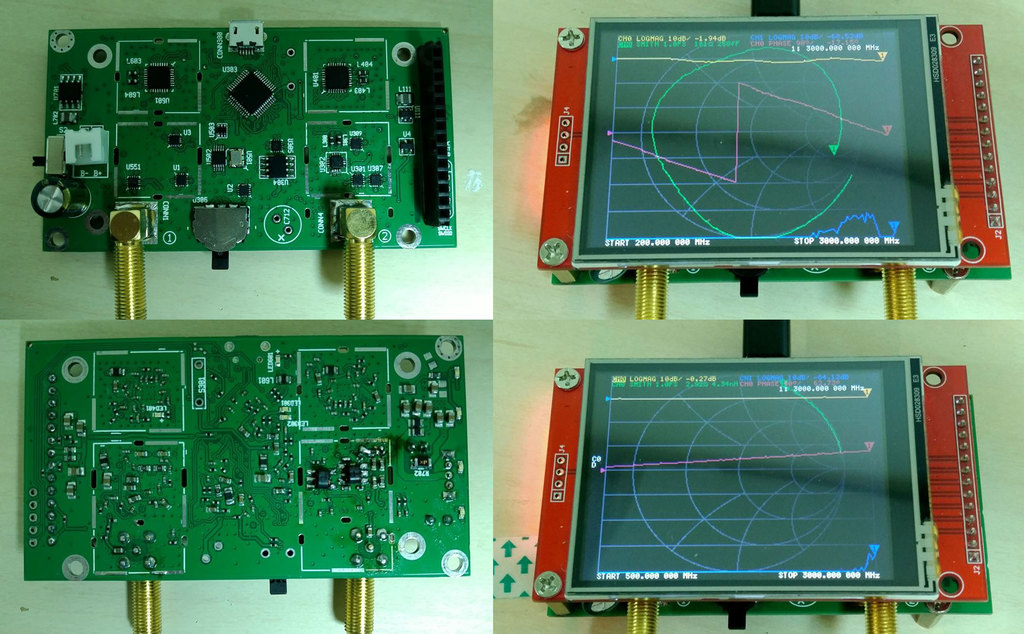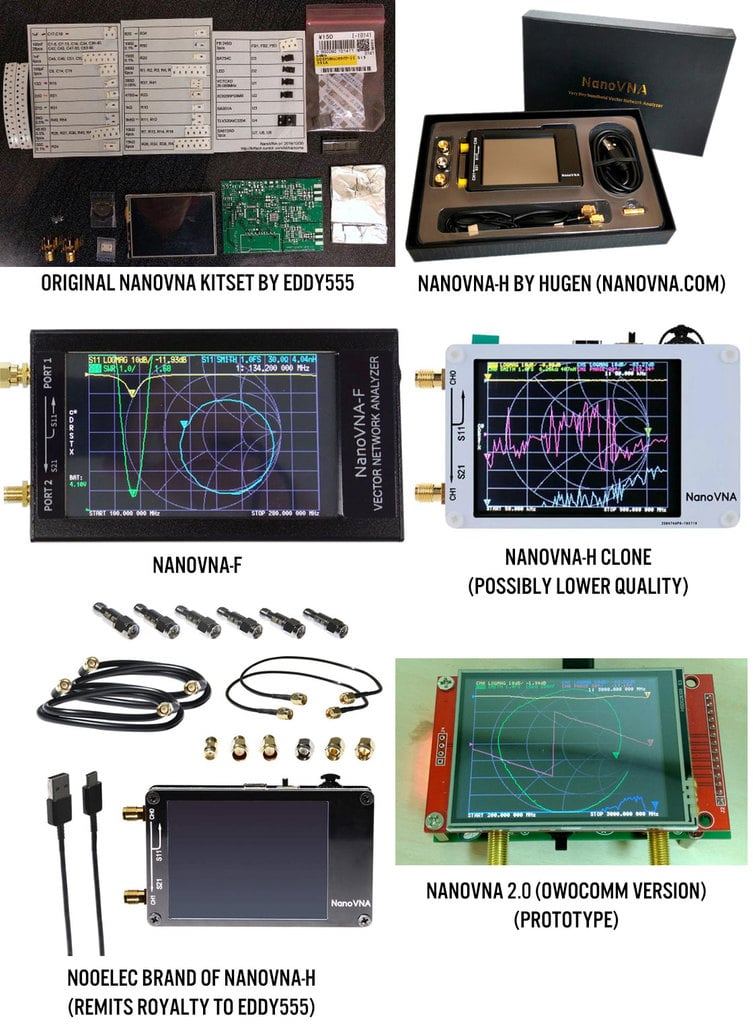NanoVNA Version 2.0 First PCB Pictures Released + NanoVNA Naming & Credit Clarifications
Back in October 2019 we posted about the upcoming NanoVNA version 2.0 which back then was still being designed with a predicted release date of January 2020. Recently some photos of the NanoVNA 2.0 prototype have been uploaded to the NanoVNA groups.io forum.
The NanoVNA 2.0 is expected to retail at around US$60 which is around the same price as the current NanoVNA. The current NanoVNA is limited in that it can only measure from 50 kHz to 900 MHz, with performance being reduced above 300 MHz. It can be extended to 1.5 GHz, but with severely reduced performance. The NanoVNA 2.0 will be able to measure from 50 kHz to 3 GHz, and possibly up to 3.5 GHz. Version 2.0 will also have improved dynamic range.
The NanoVNA (v1.0) is a versatile Vector Network Analyzer (VNA) that was originally designed by @edy555 / ttrftech. What makes it so special is it's extremely low cost as it can be found on eBay & Aliexpress for under US$40 and on Amazon for around US$50-US$70. A VNA is an extremely useful tool in any ham or RF enthusiasts tool belt as it can be used to measure RF filters, tune antennas, measure coax cable loss, and find cable faults.

NanoVNA Version, Model, Naming and Credit Confusion
Eddy555's original NanoVNA design has already been released for several years prior to the current NanoVNA popularity boom, but during those years eddy555 was only selling the product in small quantities as a DIY kitset.
The current low cost NanoVNA's available on the market now are mostly the "hugen" version known as the NanoVNA-H. Hugen is a ham who innovated on eddy555's original open source design, adding features like battery management, improved PCB layout, PC software and extending the frequency range from 300 MHz to 900 MHz.
Hugen began by making 50 units of his design to sell to some hams who had been following his design improvements online. However, hugen's design was soon cloned by other Chinese factories and this is when the NanoVNA product took off and became a well known name for an affordable VNA. The Hugen NanoVNA-H is now being sold at nanovna.com, and there are several clones available on Aliexpress that are both black and white in color. Some of the clones omit the shielding which can cause issues in some RF environments. As far as we know, the only NanoVNA-H distributor that decided to pay royalties to back eddy555 (after this exchange [part 2 resolution] on Twitter) is NooElec who sell a full NanoVNA bundle for US$109.
There is now also the "NanoVNA-F" version available which is a clone of the "NanoVNA-H" but with a larger 4.3" screen, larger battery, range extended to 1 GHz, and firmware based on a RToS. It sells at a much higher price of US$110 - US$129.
Finally, we note that the NanoVNA 2.0 project described in the first part of this post does not appear to be affiliated with eddy555 or hugen in any way. Development of the NanoVNA 2.0 is apparently based on completely original design work, and only shares similarity to the original NanoVNA in terms of pricing, name, and firmware compatibility. NanoVNA 2.0 is being developed by OwOComm which is a Japanese research unit that aims to promote "intellectual communism".
OwOComm note that they will release the designs as open source without actually manufacturing the product. It's then up to any factory to manufacture and sell the design as they please. OwOComm themselves appear to be sponsored by an unnamed customer of theirs who wanted an "improved NanoVNA" to be designed. It's not clear what the goals of OwOComm or their unnamed sponsor is, other than perhaps philanthropic.
At the same time we note that eddy555 appears to be designing his own NanoVNA 2.0 version which is not affiliated with the NanoVNA 2.0 described in this post. In the forum thread eddy555 has urged OwOComm to rename their project to avoid confusion, but it is unclear if they will do so.
The story of an open source project running away from the original developer seems to be a fairly common one these days. While eddy555's original open source design has started something truly great, it is at the same time sad that he won't see much credit or profit from future designs.

This is an open source success story. Just like the GM328 component (transistor) checker. The ones who are profiting from this are the end users, which is exactly the way it should be for an open source project. The reason why this is so popular is because it is open source and anyone can make it. If it weren’t open source, it would still be an obscure product somewhere. Has anyone ever heard of the Foxdelta antenna analyzer? It’s not open source, so it’s a yesterday’s has been because no one has been driving innovation on it. What edy555 is getting is the recognition as being the original designer of an incredible piece of equipment. I’m grateful to him, and to hugen, and to OwOComm. If you think the Chinese manufacturers are making a lot of money off this then you are dreaming. The competition is cutthroat, which is why you have to be careful on AliExpress because they will shave off stuff to save a penny. That being said, they are doing their part too by bringing this great project to the masses. No, this is nothing to be sad about. This is an open source success story and something to be lauded.
I found this nanovna v2 on eBay;
https://www.ebay.com/itm/3G-Vector-Network-Analyzer-S-A-A-2-NanoVNA-V2-Antenna-Analyzer-Short-Wave-HF-/264673437293?_trksid=p2385738.m4383.l4275.c10
Has anyone tested it yet?
A nice hounsing for the NanoVNA V2: https://www.ebay.de/itm/174232796658
The connectors on the OwOComm version look enormous compared to the others. Are they still SMA?
They look like F-connectors, which are 75 ohms, and that frankly makes me throw up in my mouth a little. If they’re planning on making this a 75 ohm VNA. I realize 75 is big in cable TV, but that’s about the only market it’s big in.
I’m 100% sure those are SMA, just the long barrel type. Useful to have the extra SMA thread length if they plan on adding an enclosure.
Thanks. I’d hate to see them abandon SMA and 50 ohm systems. It’s where most of the world works.
Firefox and Chrome both refuse connection to nanovna.com with a secure connection failure message. Info on purchase of version 3.4 from “Hugen’s Alibaba store” here:
https://groups.io/g/nanovna-users/topic/alibaba_ordering/69319901?p=,,,20,0,0,0::recentpostdate%2Fsticky,,,20,2,0,69319901
The chinese totally kill structured Innovation. Eddy555 and hugen both chose a license model that does not allow others to enrich in their work. Chinese never care about plagiarism. If I started a PCB project I would never make the design files open source. But fortunately there are more VNAs in the market like PocketVNA or VNWA3.
You’re mistaken. Eddy555 released the software under GPLv3. The GPL specifically allows people to sell software, that is the entire business model of Red Hat and SUSE, and occurs anytime you buy a router or TV or Android phone that runs Linux. In fact, the GPL makes it illegal to prohibit the commercial sale of GPL code. (e.g. CC-NC and GPL are incompatible)
The freedom to sell code is part of the freedom of open source software. Unfortunately, many people are mistaken on what freedom means and choose open source not because they want to make a gift to the community, but solely because it’s hip.
in general, would it be possible to create a VNA by using a SDR, that is capable to transmit and receive at the same time? like LimeSDR, PlutoSDR, …
if so, are there DIY descriptions available?
Most SDR only have one mixer, so at best all you could measure is S11. But in a practical sense its not worth it. For a start you have pre selector filters on a receiver that limit bandwidth, you would have to remove or bypass them for a start and then your SDR becomes less than useful as a receiver.
check the examples here: https://github.com/myriadrf/pyLMS7002Soapy